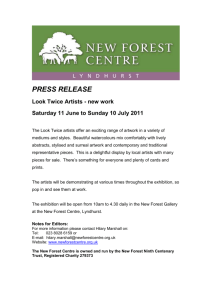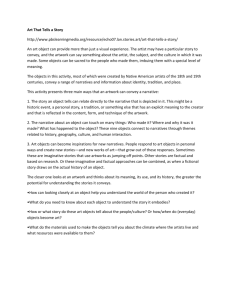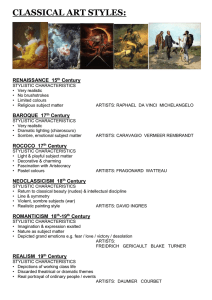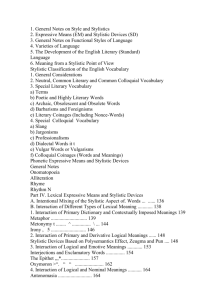Arts Curriculum Framework
advertisement
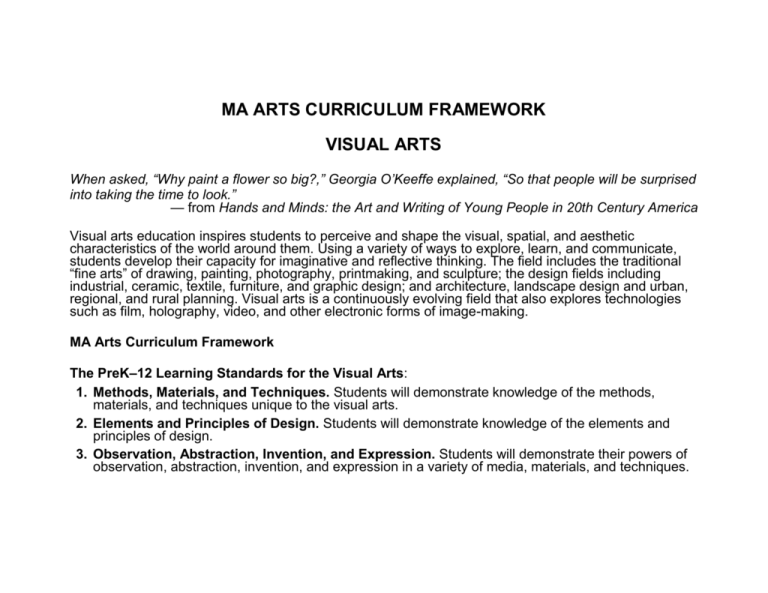
MA ARTS CURRICULUM FRAMEWORK VISUAL ARTS When asked, “Why paint a flower so big?,” Georgia O’Keeffe explained, “So that people will be surprised into taking the time to look.” — from Hands and Minds: the Art and Writing of Young People in 20th Century America Visual arts education inspires students to perceive and shape the visual, spatial, and aesthetic characteristics of the world around them. Using a variety of ways to explore, learn, and communicate, students develop their capacity for imaginative and reflective thinking. The field includes the traditional “fine arts” of drawing, painting, photography, printmaking, and sculpture; the design fields including industrial, ceramic, textile, furniture, and graphic design; and architecture, landscape design and urban, regional, and rural planning. Visual arts is a continuously evolving field that also explores technologies such as film, holography, video, and other electronic forms of image-making. MA Arts Curriculum Framework The PreK–12 Learning Standards for the Visual Arts: 1. Methods, Materials, and Techniques. Students will demonstrate knowledge of the methods, materials, and techniques unique to the visual arts. 2. Elements and Principles of Design. Students will demonstrate knowledge of the elements and principles of design. 3. Observation, Abstraction, Invention, and Expression. Students will demonstrate their powers of observation, abstraction, invention, and expression in a variety of media, materials, and techniques. 4. Drafting, Revising, and Exhibiting. Students will demonstrate knowledge of the processes of creating and exhibiting their own artwork: drafts, critique, self-assessment, refinement, and exhibit preparation. 5. Critical Response. Students will describe and analyze their own work and the work of others using appropriate visual arts vocabulary. When appropriate, students will connect their analysis to interpretation and evaluation. Connections Strand, beginning on page 75: 6. Purposes of the Arts. Students will describe the purposes for which works of dance, music, theatre, visual arts, and architecture were and are created, and, when appropriate, interpret their meanings. 7. Roles of Artists in Communities. Students will describe the roles of artists, patrons, cultural organizations, and arts institutions in societies of the past and present. 8. Concepts of Style, Stylistic Influence, and Stylistic Change. Students will demonstrate their understanding of styles, stylistic influence, and stylistic change by identifying when and where art works were created, and by analyzing characteristic features of art works from various historical periods, cultures, and genres. 9. Inventions, Technologies and the Arts. Students will describe and analyze how performing and visual artists use and have used materials, inventions, and technologies in their work. 10. Interdisciplinary Connections. Students will apply their knowledge of the arts to the study of English language arts, foreign languages, health, history and social science, mathematics, and science and technology/engineering. MA Arts Curriculum Framework Arts Disciplines: Visual Arts Strand Topic 16: Methods, Materials, and Techniques 1.5. Expand the repertoire of 2D and 3D art processes, techniques, and materials with a focus on the range of effects possible within each medium, such as: 2D - transparent and opaque media, wet, dry, stippled, blended, wash effects; relief printmaking effects; 3D - mobile and stabile forms, carved, molded, and constructed forms 1.6. Create artwork that demonstrates an awareness of the range and purpose of tools, such as pens, brushes, markers, cameras, tools and equipment for printmaking and sculpture, and computers. 1.7. Use the appropriate vocabulary related to the methods, materials, and techniques students have learned and used in grades PreK-8. 1.8. Maintain the workspace, materials, and tools responsibly and safely. Topic 17: Elements and Principles of Design Students will demonstrate knowledge of the elements and principles of design. 2.7. For color, use and be able to identify hues, values, intermediate shades, tints, tones, complementary, analogous, and monochromatic colors. Demonstrate awareness of color by painting objective studies from life and free-form abstractions that employ relative properties of color. 2.8. For line, use and be able to identify various types of line, for example in contour drawings, calligraphy, freehand studies from observation, memory, and imagination, and schematic studies. 2.9. For texture, use and be able to differentiate between surface texture and the illusion of texture (visual texture). 2.10. For shape, form, and pattern, use and be able to identify an expanding and increasingly sophisticated array of shapes and forms, such as organic, geometric, positive and negative, or varieties of symmetry. Create complex patterns, for example, reversed shapes and tessellation. 2.11. For space and composition, create unified 2D and 3D compositions that demonstrate an understanding of balance, repetition, rhythm, scale, proportion, unity, harmony, and emphasis. Create 2D compositions that give the illusion of 3D space and volume. Topic 18: Observation, Abstraction, Invention, and Expression Students will demonstrate their powers of observation, abstraction, invention, and expression in a variety of media, materials, and techniques. 3.4. Create 2D and 3D representational artwork from direct observation in order to develop skills of perception, discrimination, physical coordination, and memory of detail. 3.5. Create symbolic artwork by substituting symbols for objects, relationships, or ideas. 3.6. Create artwork that employs the use of free form symbolic imagery that demonstrates personal invention, and/or conveys ideas and emotions. 3.7. Create artwork that shows knowledge of the ways in which architects, craftsmen, and designers develop abstract symbols by simplifying elements of the environment. Topic 19: Drafting, Revising, and Exhibiting Students will demonstrate knowledge of the processes of creating and exhibiting their own artwork: drafts, critique, self-assessment, refinement, and exhibit preparation. 4.4. Produce work that shows an understanding of the concept of craftsmanship. 4.5. Demonstrate the ability to describe preliminary concepts verbally; to visualize concepts in clear schematic layouts; and to organize and complete projects. 4.6. Demonstrate the ability to articulate criteria for artistic work, describe personal style, assess and reflect on work orally and in writing, and to revise work based on criteria developed in the classroom. 4.7. Maintain a portfolio of sketches and finished work. 4.8. Create and prepare artwork for group or individual public exhibitions. Topic 20: Critical Response Students will describe and analyze their own work and the work of others using appropriate visual arts vocabulary. When appropriate, students will connect their analysis to interpretation and evaluation. 5.5. Demonstrate the ability to recognize and describe the visual, spatial, and tactile characteristics of their own work and that of others. 5.6. Demonstrate the ability to describe the kinds of imagery used to represent subject matter and ideas, for example, literal representation, simplification, abstraction, or symbolism. 5.7. Demonstrate a fundamental awareness of architectural styles and the ways that these have influenced painting and sculpture. PreK–12 STANDARD 6: Purposes and Meanings in the Arts Students will describe the purposes for which works of dance, music, theatre, visual arts, and architecture were and are created, and, where appropriate, interpret their meanings. 6.3 Interpret the meanings of artistic works by explaining how the subject matter and/or form reflect the events, ideas, religions, and customs of people living at a particular time in history For example, at the Museum of Fine Arts in Boston, students view John Singleton Copley’s portrait of Paul Revere and examples of Revere’s silverware. What do these works reveal about attitudes toward artistry in 18th century America? 6.4 Describe how artistic production can shape and be influenced by the aesthetic preferences of a society Connections Strand Topic 21: Purposes and Meanings in the Arts Students will describe the purposes for which works of dance, music, theatre, visual arts, and architecture were and are created, and, where appropriate, interpret their meanings. Topic 22: Roles of Artists in Communities 7.2. Describe the roles of artists in specific cultures and periods, and compare similarities and differences in these roles, considering aspects such as: the conditions under which artists created, performed, and/or exhibited work and the status of artists ; the sources of support for the arts; and the ways, such as apprenticeship or training, in which students learned the skills and knowledge that qualified them to produce or perform artistic work. 7.3. Identify and describe careers in at least one art form. 7.4. Describe the function of cultural organizations and arts institutions such as museums, symphonies, repertory theatres, dance companies, and historical preservation organizations. 8: Concepts of Style, Stylistic Influence, and Stylistic Change 8.4 Identify American styles and genres of dance, music, theatre, or visual arts and architecture, describe their sources, trace their evolution, and cite wellknown artists associated with these styles 8.5 Identify and describe characteristic features of genres and styles from a variety of world cultures and cite well-known artists associated with these styles Topic 23: Concepts of Style, Stylistic Influence, and Stylistic Change Students will demonstrate their understanding of the concepts of style, stylistic influence, and stylistic change by identifying when and where art works were created and by analyzing characteristic features of art works from various historical periods, cultures, and genres. Topic 24: Inventions, Technologies, and the Arts Students will describe and analyze how performing and visual artists use and have used materials, inventions, and technologies in their works. 9.2. Identify and describe examples of how the discovery of new inventions and technologies, or the availability of new materials brought about changes in the arts in various time periods and cultures. 9.3. Identify and describe examples of how artists make innovative uses of technologies and inventions. 9.4. Identify and describe examples of how contemporary artists use computer technology in their work. Topic 25: Interdisciplinary Connections Students will use knowledge of the arts and cultural resources in the study of the arts, English language arts, foreign languages, health, history and social science, mathematics, and science and technology/engineering. 10.2. Continue the above and apply knowledge of other disciplines in learning in and about the arts.

